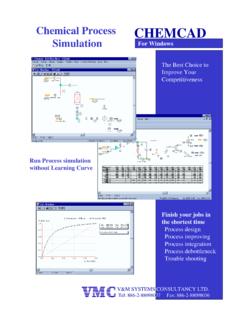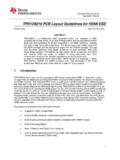Transcription of Defense Technical Information Center Compilation …
1 UNCLASSIFIEDD efense Technical Information CenterCompilation Part NoticeADPO10974 TITLE: MB-339CD Aircraft Development COTS Integration in a ModemAvionics ArchitectureDISTRIBUTION: Approved for public release, distribution unlimitedThis paper is part of the following report:TITLE: Strategies to Mitigate Obsolescence in Defense Systems UsingCommercial Components [Strategies visant a attenuer l'obsolescence dessystemes par l'emploi de composants du commerce]To order the complete Compilation report, use: ADA394911 The component part is provided here to allow users access to individually authored sectionsf proceedings, annals, symposia, etc. However, the component should be considered within[he context of the overall Compilation report and not as a stand-alone Technical following component part numbers comprise the Compilation report:ADPO10960 thru ADPO10986 UNCLASSIFIED19-1MB-339CD Aircraft DevelopmentCOTS Integration in a Modern Avionics ArchitectureR.]
2 Sabatini M. MassariItalian Air Force Logistics Command -First Division (CSV) Aermacchi Flight Test Centre (RSV) Training Aircraft DivisionAeroporto Pratica di Mare Via Ing. P. Foresio, 100040 Pomezia (Roma) -Italy 21040 Venegono Superiore (VA) -Italye-mail: e-mail: INTRODUCTION equipment is deliberately described in general terms,omitting any manufacturer of electromechanical instruments andnavigation sensors is one of the main reasons for newavionics development in military training aircraft 2. MB-339CD AVIONICS upgrade growing requirements for advanced trainers in the Generalrole of lead-in-fighter aircraft push the development ofintegrated avionics system where cockpit displays, The Aermacchi MB-339CD aircraft (Fig.)
3 1) is a singlemission computer, solid-state navigation sensors, engine, tandem seat jet trainer designed for advancedcommunication transceivers and flight data recorders and lead-in-fighter training in order to allow pilot'sare extensively employed, conversion to the latest generation of use of COTS (Commercial Of The Shelf) solutionsallows to mitigate components obsolescence and tomeet the new operational requirements at an affordablecost with reasonable development purpose of this paper is to provide an overview ofhow these concepts have been applied in thedevelopment of an innovative, modular and reliableavionics latest version of the proven MB-339 twin seat jetpowered advanced trainer employs a modern state-of-the-art avionics architecture based on standard businterface ( , MIL-STD-1553 and ARINC 429), Figure1.
4 MB-339CD to easily integrate COTS system exhibits a full glass cockpit with three The aircraft was designed, developed and tested in theidentical and interchangeable Multifunction Displays, middle of the 90's and is currently in service with theHead-up Display and independent get-home Italian Air Force. The first flight was performed oninstrumentation for back-up flight data presentation: all April 1996 while the Final Operational Capabilitythe cockpit displays use COTS active matrix full colour (FOC) was reached on October 1998; an improvedhigh resolution LCD's. version of the aircraft, with additional capabilities, willCOTS solutions are applied at hardware level in be delivered on December processing, interface and memory devices,providing state-of-the-art high performance digital The MB-339CD aircraft design is based on the proventechnology solutions, airframe structure, engine and general systems ( ,Radio navigation equipment, air data computer and an fuel, hydraulic, electrical, flight controls and landingembedded inertial-GPS platform are employed as gear)
5 Fully qualified on the MB-339A model, while aproven, off-the-shelf and fully qualified military new avionics system is fitted in order to enable trainingequipment, with modern operational techniques, including use ofan Head-up Display (HUD), Hands On Throttle andThe paper highlights the advantages gained by the Stick (HOTAS), and Multifunction Displays (MFD's),employment of COTS solutions in a modern, flexible enhancing mission effectiveness and aircraftand expandable avionics architecture. In the paper, the survivability (Fig. 2).Paper presented at the RTO SC] Symposium on "Strategies to Mitigate Obsolescence in Defense SystemsUsing Commercial Components ", held in Budapest, Hungary, 23-25 October 2000, and published in RTO MP-0 to the avionics updating, the MB-339CD fills -Radar Altimeterthe gap between traditional trainers and new combataircraft.
6 ComputersThe MB-339CD avionics is based on a modern -Mission Processor (MP)architecture using digital data buses as mean of on- -Data Transfer System with embedded Digital Mapboard Information exchange between sensors, Generator (DMG)computers and cockpit displays. -Engine Instrument and Crew Alerting System(EICAS) Data Acquisition Box (EDAB)-Stores Management System (SMS)Recorders-Flight Data Recorder (FDR) with CrashSurvivable Memory Unit (CSMU)-Video Cassette Recorder (VCR)Controls and DisplaysHead-up Displays (HUD) with embedded DataEntry Panel (DEP)Multifunction Displays (MFD)HOTAS controlsHeading/Course and Baro/Altitude rotary controlsThese components are interconnected, directly orthrough adequate interfaces, by a MIL-STD-1553 dualredundant data bus called Avionics Bus (Fig.)
7 3).The Avionics Bus is mainly controlled by the MissionProcessor which acts as the primary Bus Controller; inthe event of a critical Mission Processor failure, theEGI system is able to provide back-up bus controllercapability assuring complete equipment such as EDAB, MP, FDR includeanalog, discrete, video and digital interfaces in order toFig. 2. MB-339CD Cockpit Layout. allow the acquisition of the parameters provided byaircraft devices (general systems transducers, HOTASThe installed navigation sensors, processing equipment and rotary controls) and to allow the integration ofand electronic displays not only exhibit high equipment which have non-1553 in terms of accuracy, growth potentialand man-machine interface, but also show improved The system architecture is characterised by areliability reducing in service maintenance costs.
8 Distributed processing capability which allows arationale and simple allocation of the system functions:This section provides a description of the aircraft the EGI and ADC provide the navigation parameterssensors, computers, controls and displays, merged in a directly used by the primary flight displays, the EDAB fully integrated Navigation/Attack system. is based on two fully redundant and independentelectronic circuits capable to provide in digital form theparameters acquired by the general systems and Avionics Architecture MFD include 1553 interface and graphic processing, toautonomously generate the symbology based on theThe main components of the MB-339CD avionics are ifrainaalbeo h voisBsthe following: Information available on the Avionics With these important characteristics the requiredsystem redundancy is obtained without duplication of-Embedded GPS-Inertial (EGI) platform the central processing and symbology generation.
9 The-Air Data Computer with associated Pitot/Static overall result is a simple and reliable and Total Temperature Sensor (TTS)-Angle of Attack and Angle of Sideslip transducers The high level of flexibility of the avionics system,-Radio Navigation systems including VOR/ILS, coupled with the considerable computing capability ofTACAN and ADF the installed computers, allows for a remarkable growthpotential such as: self-protection systems (including a19-3 Radar Warning Receiver, a Chaff and Flares Dispenser (RECCE) system, a rangless GPS-based Air Combatand a pod mounted active ECM), a Forward Looking Manoeuvring Instrumentation (ACMI) system, andIR (FLIR) system, a pod mounted Reconnaissance embedded sensors (Radar/RWR) simulation MB-339CD Avionics Sensors through a Kalman filter.
10 This allows reduction of theMission Processor Embedded GPS Inertial (EGI) platform is a self-contained unit consisting of three Ring Laser Gyros, The GPS receiver can work in the Standard Positioningthree solid-state accelerometers and associated Service or in the Precise Positioning Service capable to guarantee accurate inertial Thanks to the GPS integration, the EGI can benavigation; embedded in the EGI is a tightly coupled commanded to align on ground and in flight with aGPS receiver module with 6 channels and P(Y) code nominal alignment time of 4 which uses pseudo-range and pseudo-range Th ArDaaCmue (D)wih soctdrate satellite (A )wth soctdPitot/Static ports and Total Temperature Sensor (TTS)The EGI supplies the navigation/attack system with includes extremely accurate pneumatic transducers and,accurate Information related to the aircraft attitude, thanks to a powerful computer, is able to provide inposition, velocities and accelerations: roll and pitch digital form the most important air data parameters.

















